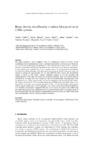Mostrar o rexistro simple do ítem
Breast density classification to reduce false positives in CADe systems
| dc.contributor.author | Vállez, Noelia | |
| dc.contributor.author | Bueno, Gloria | |
| dc.contributor.author | Déniz, Oscar | |
| dc.contributor.author | Dorado, Julián | |
| dc.contributor.author | Seoane, José A. | |
| dc.contributor.author | Pazos, A. | |
| dc.contributor.author | Pastor, Carlos | |
| dc.date.accessioned | 2016-10-14T08:39:02Z | |
| dc.date.available | 2016-10-14T08:39:02Z | |
| dc.date.issued | 2013 | |
| dc.identifier.citation | Vállez N, Bueno G, Déniz O, Dorado J, Seoane JA, Pazos A, et al. Breast density classification to reduce false positives in CADe systems. Comput Methods Programs Biomed. 2014;113(2):569-584 | es_ES |
| dc.identifier.uri | http://hdl.handle.net/2183/17436 | |
| dc.description.abstract | [Abstract] This paper describes a novel weighted voting tree classification scheme for breast density classification. Breast parenchymal density is an important risk factor in breast cancer. Moreover, it is known that mammogram interpretation is more difficult when dense tissue is involved. Therefore, automated breast density classification may aid in breast lesion detection and analysis. Several classification methods have been compared and a novel hierarchical classification procedure of combined classifiers with linear discriminant analysis (LDA) is proposed as the best solution to classify the mammograms into the four BIRADS tissue classes. The classification scheme is based on 298 texture features. Statistical analysis to test the normality and homoscedasticity of the data was carried out for feature selection. Thus, only features that are influenced by the tissue type were considered. The novel classification techniques have been incorporated into a CADe system to drive the detection algorithms and tested with 1459 images. The results obtained on the 322 screen-film mammograms (SFM) of the mini-MIAS dataset show that 99.75% of samples were correctly classified. On the 1137 full-field digital mammograms (FFDM) dataset results show 91.58% agreement. The results of the lesion detection algorithms were obtained from modules integrated within the CADe system developed by the authors and show that using breast tissue classification prior to lesion detection leads to an improvement of the detection results. The tools enhance the detectability of lesions and they are able to distinguish their local attenuation without local tissue density constraints. | es_ES |
| dc.language.iso | eng | es_ES |
| dc.publisher | Elsevier | es_ES |
| dc.relation.uri | http://dx.doi.org/10.1016/j.cmpb.2013.10.004 | es_ES |
| dc.rights | Atribución-NoComercial-SinDerivadas 3.0 España | es_ES |
| dc.rights.uri | http://creativecommons.org/licenses/by-nc-nd/3.0/es/ | * |
| dc.subject | Breast tissue classification | es_ES |
| dc.subject | Weighted voting tree classifier | es_ES |
| dc.subject | Texture analysis | es_ES |
| dc.subject | CADe system | es_ES |
| dc.subject | False positive reduction | es_ES |
| dc.title | Breast density classification to reduce false positives in CADe systems | es_ES |
| dc.type | info:eu-repo/semantics/article | es_ES |
| dc.rights.access | info:eu-repo/semantics/openAccess | es_ES |
| UDC.journalTitle | Computer Methods and Programs in Biomedicine | es_ES |
| UDC.volume | 113 | es_ES |
| UDC.issue | 2 | es_ES |
| UDC.startPage | 569 | es_ES |
| UDC.endPage | 584 | es_ES |
Ficheiros no ítem
Este ítem aparece na(s) seguinte(s) colección(s)
-
GI-RNASA - Artigos [175]






